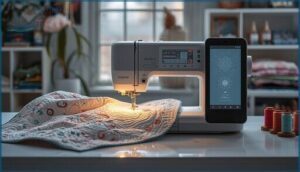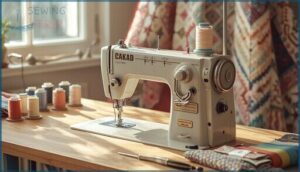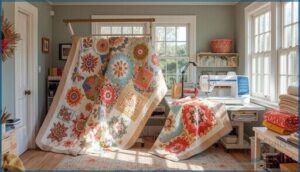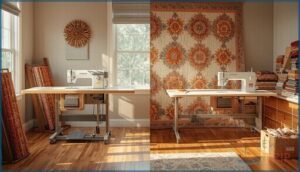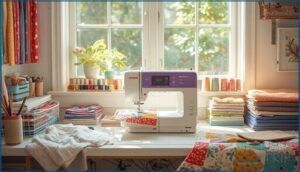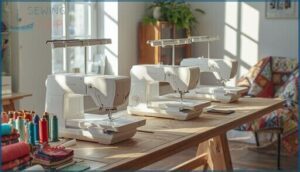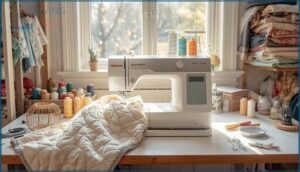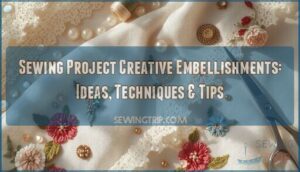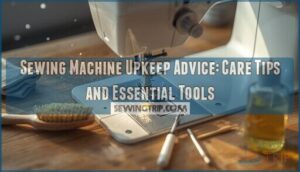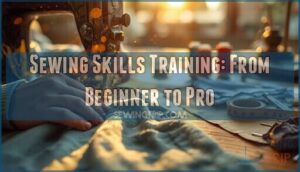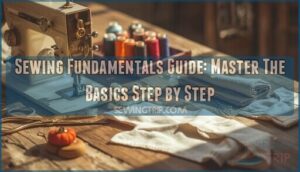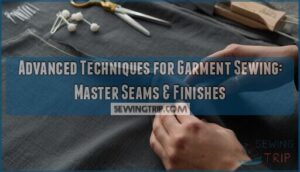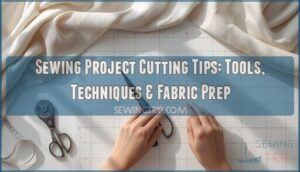This site is supported by our readers. We may earn a commission, at no cost to you, if you purchase through links.
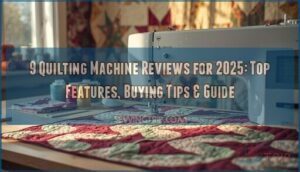
We tested nine quilting machines across different price points and skill levels, comparing throat space, stitch quality, speed, and ease of use. Whether you’re piecing your first baby quilt or finishing your tenth heirloom project, this guide helps you find a machine that matches your needs and budget.
Table Of Contents
- Key Takeaways
- Best Quilting Machines Reviewed in 2024
- 1. Juki HZL F600 Sewing Quilting Machine
- 2. Brother PQ1600S High Speed Sewing Machine
- 3. SINGER Quantum Stylist Sewing Machine
- 4. Brother XR3774 Sewing and Quilting Machine
- 5. Brother HC1850 Sewing and Quilting Machine
- 6. JUKI TL-2000Qi Sewing Quilting Machine
- 7. Janome MC6650 Sewing Quilting Machine
- 8. Bernette B77 Sewing Quilting Machine Bundle
- 9. Brother Computerized Sewing Quilting Machine White
- Key Features to Look for in Quilting Machines
- Types of Quilting Machines Explained
- How to Choose The Right Quilting Machine
- Tips for Buying and Maintaining Your Quilting Machine
- Frequently Asked Questions (FAQs)
- Conclusion
Key Takeaways
- The right quilting machine depends on matching your skill level, budget, and project needs to key features like throat space (7-9 inches for beginners), stitch quality, and speed rather than chasing unnecessary bells and whistles.
- Regular maintenance—including cleaning after every project, proper oiling, and changing needles every eight hours of use—makes the difference between smooth stitching and frustrating jams that shorten your machine’s lifespan.
- Computerized machines offer automation and pattern customization through LCD screens, while mechanical models provide hands-on control with fewer electronic parts that can fail, making them more affordable and durable for straightforward quilting.
- Extension tables and adequate throat space (the area between the needle and machine body) are critical for maneuvering bulky king-sized quilts, while features like walking feet and free-motion capabilities give you professional control over thick layers and custom designs.
Best Quilting Machines Reviewed in 2024
If you’re sorting through all the quilting machines out there, you’re not alone.
Here are nine of the best models making waves in 2024. Take a look and see which one might fit what you’re after.
1. Juki HZL F600 Sewing Quilting Machine
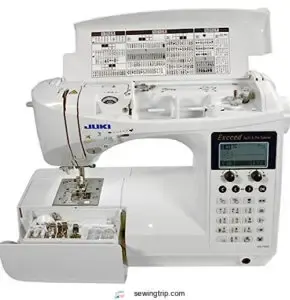
When you’re eyeing the Juki HZLF600 quilting machine, you’re investing in a blend of top-tier stitch quality and real speed performance. Its 225 stitch options, sturdy build reliability, and thoughtful extras—like the knee lifter and quiet operation—make long quilting sessions less of a chore.
The large throat space and straightforward user interface almost anticipate your next move. While the market value sits on the higher side, you’re getting a user experience that fosters exploration and serious productivity in your quilting.
Best For: Experienced home quilters or sewing enthusiasts who want reliable performance, built-in versatility, and heavy-duty durability for sizable quilting projects.
- Exceptional stitch quality and smooth, quiet operation even on larger quilts
- Generous throat space and knee-lift for tackling bulky or intricate work
- Wide range of built-in stitches and user-friendly controls make advanced projects easier
- High price point puts it out of reach for casual or entry-level users
- Manual and needle threader can be frustrating or require a learning curve
- Can struggle with very thick fabrics and is quite heavy and stationary
2. Brother PQ1600S High Speed Sewing Machine
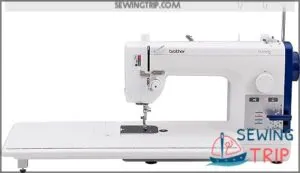
Where the Juki shines for versatility, the Brother PQ1600S jumps to the front with sheer speed and a heavy-duty build. This high-speed quilting machine blazes through straight seams at up to 1,500 stitches per minute and makes thick layers feel easy.
The workspace extension, unique pin feed system, and smooth tension adjustments help you wrangle large, tricky projects without fuss. For anyone chasing professional results in quilting or sewing, this sewing machine offers reliable power and practical finesse.
Best For: Serious sewists and quilters who want high speed, power, and room to handle big projects with ease.
- Impressive 1,500 stitches per minute speeds up everything from quilting to thick fabrics.
- Huge workspace and extension table are perfect for handling bulky pieces and large quilts.
- Pin feed system and smooth tension control keep stitches even on tricky or layered materials.
- Side-loading bobbin and top tension dial can be awkward for beginners to use.
- Needle threader is finicky, especially with cheaper threads.
- Machine can get noisy or squeaky after heavy use.
3. SINGER Quantum Stylist Sewing Machine
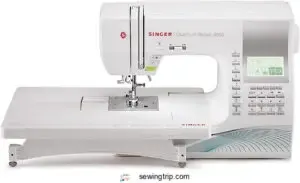
After tackling heavy-duty projects, you might be wondering about a quilting machine that’s designed for detail and creativity. The Singer 9960 steps up here, offering huge Stitch Customization and User Friendliness right out of the gate. You get 600 stitches, five fonts, and handy features like an automatic thread cutter.
Its Included Accessories—18 presser feet, extension table, and hard case—add real value.
But a close Performance Review shows some Usage Challenges for precise quilt piecing, especially with the feed dog arrangement.
Best For: Quilters and sewing enthusiasts who want lots of built-in stitches, easy automatic features, and value-packed accessories in one machine.
- 600 stitches, customizable designs, and five included fonts for true creative freedom
- Automatic needle threader and thread cutter make setup and finishing a breeze
- Comes with 18 presser feet, an extension table, and a hard case—everything right in the box
- Feed dog arrangement can make getting a truly precise quarter-inch seam tricky for serious quilt piecing
- Average harp (throat) size might feel cramped for larger quilting projects
- Some users will need time to adjust to accessory features like the thread cutter and seam guides
4. Brother XR3774 Sewing and Quilting Machine
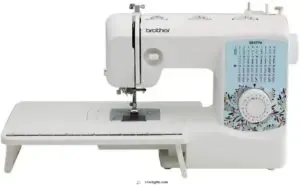
If you want a quilting machine that covers the basics without overwhelming you, the Brother XR3774 checks a lot of boxes. Portability factors in—it’s light, easy to move, and doesn’t eat up table space.
You’ll find just enough stitch versatility (37 stitches) for traditional quilting, with an automatic needle threader to sweeten the experience. Its beginner friendliness stands out: setup is a breeze, and the included wide table offers support for bulky projects.
For sheer value proposition, it keeps your budget happy.
Best For: Beginners and hobbyists who want an affordable, user-friendly sewing machine that handles basic quilting and everyday sewing.
- Lightweight, portable, and easy to set up.
- Offers 37 built-in stitches and a wide table for quilting projects.
- Automatic needle threader and top drop-in bobbin simplify use for newcomers.
- Not designed for thick or heavy-duty materials.
- Feed dogs don’t drop automatically for free-motion quilting; requires a darning plate.
- Basic user manual may leave some details unclear, so extra guidance could be needed.
5. Brother HC1850 Sewing and Quilting Machine
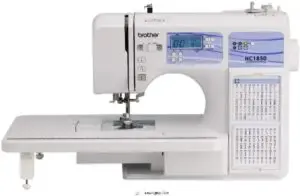
Looking for a quilting machine that balances HC1850 Value, Beginner Friendliness, and reliable Stitch Quality? The Brother HC1850 is right in the sweet spot.
It’s lightweight and easy to shift from table to class—earning high marks in any Portability Review—while still offering a buffet of stitches and quilting features. With the oversized extension table, free-motion foot, and easy-to-grasp controls, you don’t feel boxed in.
The 25-year limited warranty promises peace of mind, making this sewing machine a strong companion for everyday quilting.
Best For: Beginners and hobbyists looking for an affordable, reliable sewing and quilting machine packed with versatile features.
- Lightweight and portable, easy to take to sewing classes.
- Wide variety of stitches and quilting accessories included for creative projects.
- User-friendly design with clear LCD and automatic needle threader.
- Not suitable for heavy-duty fabrics or thick quilting layers.
- Limited throat space can be challenging for large quilts.
- Only for US use at 120V; warranty voided otherwise.
6. JUKI TL-2000Qi Sewing Quilting Machine
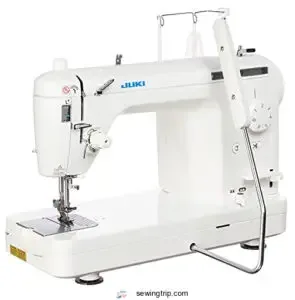
One standout in quilting machine reviews is the Juki TL2000Qi, a blend of high-speed stitching (up to 1,500 SPM) and rugged, durable construction. If you crave precision and strength for Free-Motion Quilting or maneuvering multiple layers, this quilting machine steps up with an extended workspace and smooth operation.
User feedback often highlights quiet reliability and professional results. Just remember, regular oiling is part of the routine maintenance needs, making it a true long-term partner for serious quilters.
Best For: Quilters and sewists who want a high-speed, heavy-duty straight stitch machine built for precision quilting, thick fabrics, and expanded workspace.
- Very fast at up to 1,500 stitches per minute for quick project turnaround
- Excellent for free-motion quilting and heavy materials with low vibration and precise control
- Spacious extension table and reliable automatic needle threader make large projects easier
- Only does straight stitching, so not ideal for decorative or zigzag work
- Can be heavy and a bit cumbersome to move or lift
- May require extra feet or accessories for specialized quilting techniques
7. Janome MC6650 Sewing Quilting Machine
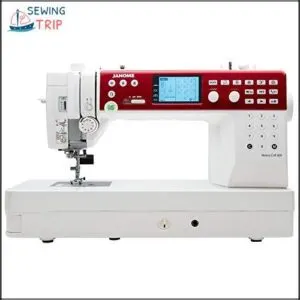
When you explore the Janome MC6650, you’ll notice how stitch quality and machine durability stand tall above ordinary sewing machines. The 10″ all-metal flatbed and speedy 1,000 SPM output give you real confidence working on large quilting applications.
A bright, approachable interface with easy controls streamlines your creative flow. Plus, maintenance needs are straightforward—regular cleaning and oil keep things running smooth.
For quilters aiming for professional results without hassle, this quilting machine truly earns its top spot in quilting machine reviews.
Best For: Quilters and sewists seeking a powerful, reliable machine for large projects and fast, precise stitching.
- Fast 1,000 SPM speed and large work surface make it excellent for big quilts and multi-layer sewing.
- Durable all-metal build with smooth stitch quality, plus easy-to-use controls and LCD display.
- Loaded with features like automatic thread cutter, needle threader, and strong lighting for a stress-free sewing experience.
- High price tag at $1999 makes it a big investment for hobbyists.
- Some users report occasional skipped stitches or issues with the thread cutter.
- Instruction booklet may be unclear, so beginners could need extra guidance.
8. Bernette B77 Sewing Quilting Machine Bundle
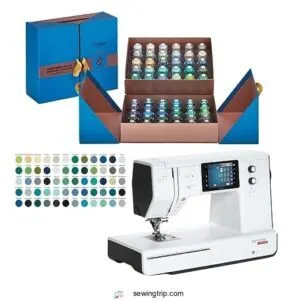
Ever imagine quilting with a machine that truly feels like an upgrade? The Bernette B77 stands out for its big 5-inch touchscreen interface and hefty list of stitch options, giving you a playground for creativity.
Its Dual Feed manages multiple layers with ease—think smooth sailing on everything from chiffon to bulky quilts.
Solid warranty coverage, plus a generous extension table, highlight its strong market position. If you’re after a feature-rich sewing and quilting machine that doesn’t break the bank, this bundle delivers.
Best For: Intermediate and advanced sewists who want a computerized machine for larger quilting and sewing projects without jumping to the highest price tier.
- Loaded with 500 built-in stitches and a big touchscreen for easy control
- Dual feed makes sewing multiple layers, even with delicate or thick materials, much smoother
- Comes with a strong warranty and a wide set of accessories, making it a complete package
- Thread tension sometimes needs manual adjustment for best results
- Some users report issues with the thread cutter and motor reliability
- Customer support can be slow or unresponsive at times
9. Brother Computerized Sewing Quilting Machine White
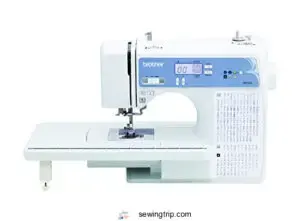
The Brother CS6000i delivers solid value through 165 built-in stitches and 8 buttonhole styles—giving you plenty of room to experiment. Its LCD display makes stitch selection straightforward, while the automatic needle threader speeds setup.
You’ll appreciate the wide extension table for larger quilts and the 11 included accessories, from walking feet to a hard case.
Rated 4.3 out of 5 by verified users, this computerized sewing machine accommodates both delicate fabrics and moderate quilting projects. It’s lightweight, portable, and backed by a 25-year limited warranty on the chassis.
Best For: Sewers and quilters who want a versatile, beginner-friendly machine with tons of stitch options and accessories without spending a fortune.
- 165 built-in stitches and 8 buttonhole styles give you serious creative flexibility for everything from garments to quilts.
- Comes loaded with 11 accessories including a wide table, hard case, and specialty feet—you can start projects right out of the box.
- Strong 25-year warranty on the chassis plus solid 4.3/5 rating from users shows it’s built to last and performs reliably.
- Struggles with heavy-duty or thick fabrics, so it’s not the best choice if you’re working with denim or upholstery regularly.
- Some users find the reverse button and foot pedal awkward to use, which can slow down your workflow.
- The auto-threading feature can be fragile and prone to breaking, requiring careful handling.
Key Features to Look for in Quilting Machines
Not all quilting machines are created equal, and knowing what to look for can save you time and money. The right features make the difference between smooth stitching and constant frustration.
Here’s what matters most when you’re shopping for a machine that won’t let you down.
Throat Space and Extension Table
Think of throat space as your quilting machine’s breathing room—the bigger it is, the easier you can wrangle those bulky quilt layers without wrestling them into position. Most machines offer 6 to 9 inches of throat space, which works fine for lap quilts.
Extension tables for quilting add precious workspace around your needle, giving you better maneuverability when manipulating king-size projects that would otherwise bunch up and drag.
Stitch Options and Decorative Patterns
Once you’ve got your workspace sorted, you’ll want to think about stitch variety—because even the most basic quilting machine should give you more than just a straight line to work with.
Here’s what matters when evaluating stitch options and patterns:
- Stitch variety ranges from 50 basic stitches to 600+ decorative stitches on computerized models with software integration
- Pattern complexity includes quilting stitches like stippling and echo work, plus custom stitching for designs made to order
- Stitch quality depends on tension control and precision—fancy patterns mean nothing if execution falls flat
Sewing Speed and Motor Power
Speed matters most when you’re working through a king-sized quilt, and every minute at the machine adds up. Most quilting machines run between 600 and 1,600 stitches per minute, with motor torque determining how well that speed holds up through fabric thickness.
Look for machines with speed control features and vibration dampening—these keep stitch consistency steady whether you’re racing through straight lines or slowing down for detailed work.
Built-in Needle Threader and Thread Cutter
Threading a needle thirty times in one afternoon isn’t anyone’s idea of a good time, which is why automatic needle threaders have become one of the most requested features on modern quilting machines. You’ll find threader reliability varies between brands—some work flawlessly for years while others struggle with finer threads.
Automatic thread cutters add convenience too, trimming tails cleanly without reaching for scissors. Both features save time and reduce eye strain, especially during long sessions.
LCD Screens and Computerized Controls
Modern quilting machines with LCD screens let you see stitch patterns, adjust settings, and troubleshoot errors without flipping through a manual. Computerized sewing machines with touchscreen navigation make adjustments quick and easy to use.
Key benefits include:
- Stitch customization with real-time preview
- Pattern storage for your favorite designs
- Error messaging that guides troubleshooting
- Software updates that add new features
These quilting machine LCD screen controls simplify complex stitch settings, making computerized sewing more accessible.
Free-Motion and Walking Foot Capabilities
When you’re quilting thick layers or want to stitch freely across your fabric without following a set path, free-motion and walking foot capabilities give you the control you need.
A walking foot guide feeds multiple layers evenly for straight-line quilting, while free motion stitching lets you create custom textures without fabric feed control.
Stitch regulation helps maintain consistent length during free-motion mastery, giving you professional results.
Types of Quilting Machines Explained
Not all quilting machines work the same way, and understanding the main types helps you pick one that fits your projects and space.
From high-tech computerized models to straightforward mechanical ones, each category brings its own advantages.
Here’s a look at the five main types you’ll encounter when shopping for a quilting machine.
Computerized Quilting Machines
Computerized quilting machines bring together modern technology and traditional craft, letting you tackle complex patterns with the push of a button instead of wrestling with manual adjustments. These machines use precision sensors and quilting automation to manage intricate designs that would take hours by hand. Here’s what makes them worth considering:
- Automated Stitching delivers consistent quilting machine stitch quality across every project
- Pattern Customization through LCD screens gives you control over your creative vision
- Software Updates keep your computerized quilting machine current with new features
You’ll find these machines excel at quilting machine ease of use, though they cost more upfront.
Mechanical Quilting Machines
If you prefer a hands-on approach without the bells and whistles of digital displays, mechanical quilting machines deliver reliable performance through straightforward knobs and dials that give you direct control over every stitch.
They’re built to last, with durability aspects that come from fewer electronic parts that might fail. You’ll appreciate the affordability factors, since these quilting machines cost less upfront and have minimal maintenance needs.
For beginner suitability, mechanical models let you learn quilting machine features without overwhelming computerized menus.
Longarm Vs. Midarm Quilting Machines
Choosing between longarm and midarm quilting machines depends on your project size and workspace requirements. Longarm models offer throat space from 18 to 30 inches with frames up to 14 feet, accommodating king-sized quilts at speeds of 1,800 to 2,500 stitches per minute.
Consider these key differences:
- Workspace requirements: Longarms need up to 14 feet, while midarms fit in 5-6 feet
- Quilting comfort: Midarms let you sit; longarms require standing
- Project size: Both accommodate large quilts, but longarms manage thicker batting better
- Automation features: Computerized patterns are mainly available on longarm quilting machines
- Portability options: Midarms cost $2,000-$8,000 and move easier than $10,000-$40,000 longarms
Many machines offer adjustable stitch regulation for consistent results. Your quilting capabilities expand dramatically with either choice.
Frame-Mounted Vs. Tabletop Models
Your decision between a frame-mounted and tabletop quilting machine comes down to whether you value stability for large projects or flexibility for multiple spaces. Frame-mounted models anchor to dedicated frames, eliminating vibration control issues during high-speed quilting. Tabletop versions fit standard sewing tables, making them portable when your quilting machine workspace changes.
| Factor | Frame-Mounted | Tabletop |
|---|---|---|
| Space Requirements | 8-14 feet permanent area | 2-4 feet, temporary setup |
| Portability Concerns | Fixed installation | Easily moved between rooms |
| Setup Complexity | Professional assembly recommended | Ready within minutes |
Frame systems accommodate king-sized project size better, while tabletop quilting machines work well for smaller quilts and multi-purpose sewing rooms.
Combination Sewing and Quilting Machines
Think of combination machines as the Swiss Army knife of the quilting world—they tackle everyday garment repairs and intricate quilt tops without switching equipment.
You’ll find space optimization and cost efficiency here, ideal for beginner friendliness.
These combination sewing and quilting machines offer versatility benefits through wide stitch libraries and adjustable speeds, supporting project diversity from hemming jeans to layering quilting sandwiches without dedicated gear for each task.
How to Choose The Right Quilting Machine
Picking the right quilting machine isn’t just about features—it’s about finding what fits your needs, skills, and wallet. You’ll want to think through several key factors before making your choice.
Here’s what matters most when you’re ready to invest in a quilting machine.
Matching Machine to Quilting Skill Level
Since beginners often feel overwhelmed by sophisticated features they won’t use, finding a machine that matches your experience level can save you money and frustration.
Beginner-friendly machines focus on essential stitching without complex controls, while intermediate features like adjustable speed and expanded stitch libraries support skill progression.
Complex capabilities—computerized patterns, precision tension, large throat space—suit experienced quilters tackling professional projects. Think about your current quilting abilities and where you’ll be in a year, not just today’s needs.
Setting a Budget and Evaluating Value
Once you’ve identified the right skill level, the next question is straightforward: how much should you spend? Budget-friendly quilting machines start around $200, while professional models exceed $2,000.
Feature prioritization matters—automatic threaders and speed control add value, but fancy decorative stitches mightn’t. Factor in long-term costs like maintenance and accessories.
Value assessment means comparing quilting machine price against durability and performance, not just upfront expense.
Considering Brand Reputation and Warranty
Brand trust separates solid investments from costly mistakes. Juki, Janome, Brother, SINGER, and Baby Lock consistently earn 4.5+ ratings in 2025, reflecting reliable performance. A good machine will offer ample throat space for larger projects.
Warranty duration varies widely—from Handi Quilter’s 90-day manufacturing coverage to Baby Lock’s 25-year limited protection. Customer support through authorized dealers and helplines matters when repairs arise. Watch warranty limits: normal wear items and unauthorized fixes void most coverage, and some brands require annual servicing to keep warranties active.
Assessing Ease of Use and Maintenance
A machine that’s tricky to thread or needs frequent adjustments won’t see much use, no matter how impressive its warranty looks on paper. Check these before you buy:
- Easy-to-grasp controls and user manuals—Can you figure out basic functions without hunting through pages?
- Maintenance schedule clarity—Does the guide explain cleaning cycles in plain terms?
- Ergonomic design—Will your back and shoulders thank you after hours of stitching?
- Customer support and troubleshooting tips—Is help a phone call away when things go sideways?
Easy-to-use machines cut your learning curve and keep you quilting instead of wrestling with settings.
Factoring in Accessories and Upgrade Options
Before you hand over your credit card, think about what extras might turn a good machine into your perfect quilting partner. Check foot compatibility—can you swap presser feet easily? Look for software updates on computerized models, ergonomic add-ons like knee lifts, and lighting solutions.
Quilting machine accessories and attachments matter. Customization options let your machine grow with your skills instead of outgrowing it.
Tips for Buying and Maintaining Your Quilting Machine
Getting the right quilting machine is just the start—keeping it running smoothly takes a bit of know-how.
Your machine will last longer and perform better when you follow some basic care routines and stock up on the right extras.
Here’s what you need to keep your quilting projects on track.
Importance of Regular Cleaning and Oil
Keeping your quilting machine clean and well-oiled isn’t just good practice—it’s the difference between smooth stitching and a frustrating jam at the worst possible moment.
Set a cleaning schedule based on how often you quilt. After every project, remove lint from the bobbin area and feed dogs. Use the right oil type recommended in your quilting machine warranty manual.
This preventative maintenance helps you avoid troubleshooting issues down the road and keeps your quilting machine motor running quietly for years.
Storing and Handling Your Machine Properly
When you tuck your machine away between projects, you’re either protecting your investment or slowly letting it gather damage—proper storage makes all the difference. Use a dust cover to shield it from lint and debris. Keep it in a climate-controlled space away from sunlight and humidity, which can harm electronics and affect quilting machine durability.
Wrap cords neatly to prevent damage. When transporting machines, secure them in their original case or padded bag to maintain quilting machine value and protect your quilting machine warranty coverage.
Must-Have Quilting Accessories
Your machine works better with the right tools, and a few key accessories can turn frustrating challenges into smooth, satisfying quilts. Quilting gloves give you grip for free-motion work. A walking foot manages thick layers evenly.
Keep rotary cutters, seam rippers, and quilting rulers handy for precise cuts and fixes. Stock quality thread types, and add an extension table to expand your workspace—these sewing machine accessories make every project easier.
Where to Find Reliable Customer Support
You’ll find help through multiple channels when issues pop up. Manufacturer hotlines from brands like Brother, Janome, and Juki offer direct troubleshooting and warranty options—over 85% provide dedicated support lines.
Dealer consultations give you hands-on help, with 78% offering technical assistance. Check online resources like FAQs and video tutorials first; 76% of owners solve problems this way.
For faster fixes, authorized third-party repairs average 4.2 days versus 9.1 days for manufacturer service, though warranty terms usually require certified providers.
Frequently Asked Questions (FAQs)
Which sewing and quilting machine should I buy?
Choose based on your skill level, budget considerations for quilting, and space availability.
Best quilting machines match your project size needs and feature priorities—beginners might start simple, while experienced quilters often need sophisticated capabilities for larger sewing and quilting projects.
Which quilting machine is best?
The best quilting machine depends on your skill level, budget, and quilting goals. Beginners might prefer computerized models with built-in guides, while experienced quilters often choose high-speed machines or longarm models for professional results.
Is a quilting machine a sewing machine?
Yes, quilting machines are sewing machines, but with specialized quilting capabilities. They accommodate thicker fabrics and offer larger throat space for project size flexibility.
These machines also provide enhanced stitch variety for both sewing and quilting tasks.
Should you buy a quilting machine?
If you’re serious about quilting as more than a casual hobby, investing in a quilting machine makes sense.
These machines manage larger projects better, speed up your work, and help you grow your skills as you take on more complex designs.
Why is a quilting machine better than a regular sewing machine?
Quilting machines manage thick layers better than regular sewing machines. They offer more workspace for bulky projects, faster stitching speeds, and better stitch precision.
You’ll feel less fatigue since these machines are built for quilting’s unique demands.
How much does a quilting machine cost?
Like choosing a car, quilting machines span from economy to luxury. Budget-friendly quilting machines start around $200, midrange quilting machines run $500–$1,500, and high-end quilting machines can exceed $3,
Budget considerations should weigh cost vs. benefits and long-term expenses, not just the initial machine price ranges.
Can quilting machines handle leather or vinyl?
Most quilting machines aren’t built for leather or vinyl. These fabric types demand a heavyduty machine with adjustable foot pressure, specialized needle types for leather quilting, and the capacity to manage vinyl thickness that standard sewing machine models can’t process.
Whats the ideal throat space for beginners?
For beginners, a throat space of 7 to 9 inches hits the sweet spot. This range gives you enough room to manage typical quilt blocks and lap-sized projects without feeling cramped, while keeping the machine manageable as you’re learning the ropes.
Do all quilting machines need special tables?
Not every machine requires one, but extension tables help manage larger quilts. Most tabletop quilting machines work fine on sturdy surfaces.
However, extended table space improves ergonomic benefits and holds bulky projects better.
How often should I replace quilting needles?
A needle that’s seen too many hours will give you thread breaks and uneven stitches, no matter how good your quilting machine is.
Change needles every eight hours of quilting time, or sooner with thick fabric layers and specialty quilting techniques.
Conclusion
The best tool is the one you’ll actually use. That truth applies perfectly to quilting machine reviews—the fanciest features don’t matter if the machine sits unused because it overwhelms you.
Start with your skill level and budget, then match those to throat space, speed, and stitch quality. Don’t chase bells and whistles you won’t need. Focus on what makes your current projects easier and your future quilts possible.
The right machine won’t just meet your needs—it’ll grow with them.
- https://www.qualitysewing.com/products/juki-f600-sewing-quilting-machine
- https://www.sewingmachinesplus.com/hzl-600.php
- https://sewinginsight.com/reviews/juki-hzl-exceed-f600-quilt-pro-special-review/
- https://ishoptops.com/juki-hzl-f600-computerized-sewing-quilting-machine/
- https://www.reviewdart.com/product/juki-hzl-f600-review-a-comprehensive-look-at-this-quilting-machine/

